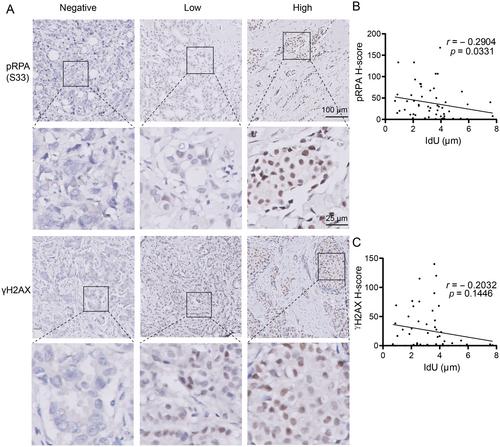Functional ex vivo DNA fibre assay to measure replication dynamics in breast cancer tissue
Mengting Chen, Nathalie van den Tempel, Arkajyoti Bhattacharya, Shibo Yu, Bea Rutgers, Rudolf SN Fehrmann, Sander de Haas, Bert van der Vegt, Marcel ATM van Vugt
下载PDF
{"title":"Functional ex vivo DNA fibre assay to measure replication dynamics in breast cancer tissue","authors":"Mengting Chen, Nathalie van den Tempel, Arkajyoti Bhattacharya, Shibo Yu, Bea Rutgers, Rudolf SN Fehrmann, Sander de Haas, Bert van der Vegt, Marcel ATM van Vugt","doi":"10.1002/path.6328","DOIUrl":null,"url":null,"abstract":"<p>Replication stress (RS) is a key trait of cancer cells, and a potential actionable target in cancer treatment. Accurate methods to measure RS in tumour samples are currently lacking. DNA fibre analysis has been used as a common technique to measure RS in cell lines. Here, we investigated DNA fibre analysis on fresh breast cancer specimens and correlated DNA replication kinetics to known RS markers and genomic alterations. Fresh, treatment-naïve primary breast cancer samples (<i>n</i> = 74) were subjected to <i>ex vivo</i> DNA fibre analysis to measure DNA replication kinetics. Tumour cell proliferation was confirmed by EdU incorporation and cytokeratin AE1/AE3 (CK) staining. The RS markers phospho-S33-RPA and γH2AX and the RS-inducing proto-oncogenes Cyclin E1 and c-Myc were analysed by immunohistochemistry. Copy number variations (CNVs) were assessed from genome-wide single nucleotide polymorphism (SNP) arrays. We found that the majority of proliferating (EdU-positive) cells in each sample were CK-positive and therefore considered to be tumour cells. DNA fibre lengths varied largely in most tumour samples. The median DNA fibre length showed a significant inverse correlation with pRPA expression (<i>r</i> = −0.29, <i>p</i> = 0.033) but was not correlated with Cyclin E1 or c-Myc expression and global CNVs in this study. Nuclear Cyclin E1 expression showed a positive correlation with pRPA levels (<i>r</i> = 0.481, <i>p</i> < 0.0001), while cytoplasmic Cyclin E1 expression exhibited an inverse association with pRPA expression (<i>r</i> = −0.353, <i>p</i> = 0.002) and a positive association with global CNVs (<i>r</i> = 0.318, <i>p</i> = 0.016). In conclusion, DNA fibre analysis performed with fresh primary breast cancer samples is feasible. Fibre lengths were associated with pRPA expression. Cyclin E1 expression was associated with pRPA and the percentage of CNVs. © 2024 The Author(s). <i>The Journal of Pathology</i> published by John Wiley & Sons Ltd on behalf of The Pathological Society of Great Britain and Ireland.</p>","PeriodicalId":232,"journal":{"name":"The Journal of Pathology","volume":"264 1","pages":"90-100"},"PeriodicalIF":5.6000,"publicationDate":"2024-07-18","publicationTypes":"Journal Article","fieldsOfStudy":null,"isOpenAccess":false,"openAccessPdf":"https://onlinelibrary.wiley.com/doi/epdf/10.1002/path.6328","citationCount":"0","resultStr":null,"platform":"Semanticscholar","paperid":null,"PeriodicalName":"The Journal of Pathology","FirstCategoryId":"3","ListUrlMain":"https://onlinelibrary.wiley.com/doi/10.1002/path.6328","RegionNum":2,"RegionCategory":"医学","ArticlePicture":[],"TitleCN":null,"AbstractTextCN":null,"PMCID":null,"EPubDate":"","PubModel":"","JCR":"Q1","JCRName":"ONCOLOGY","Score":null,"Total":0}
引用次数: 0
引用
批量引用
Abstract
Replication stress (RS) is a key trait of cancer cells, and a potential actionable target in cancer treatment. Accurate methods to measure RS in tumour samples are currently lacking. DNA fibre analysis has been used as a common technique to measure RS in cell lines. Here, we investigated DNA fibre analysis on fresh breast cancer specimens and correlated DNA replication kinetics to known RS markers and genomic alterations. Fresh, treatment-naïve primary breast cancer samples (n = 74) were subjected to ex vivo DNA fibre analysis to measure DNA replication kinetics. Tumour cell proliferation was confirmed by EdU incorporation and cytokeratin AE1/AE3 (CK) staining. The RS markers phospho-S33-RPA and γH2AX and the RS-inducing proto-oncogenes Cyclin E1 and c-Myc were analysed by immunohistochemistry. Copy number variations (CNVs) were assessed from genome-wide single nucleotide polymorphism (SNP) arrays. We found that the majority of proliferating (EdU-positive) cells in each sample were CK-positive and therefore considered to be tumour cells. DNA fibre lengths varied largely in most tumour samples. The median DNA fibre length showed a significant inverse correlation with pRPA expression (r = −0.29, p = 0.033) but was not correlated with Cyclin E1 or c-Myc expression and global CNVs in this study. Nuclear Cyclin E1 expression showed a positive correlation with pRPA levels (r = 0.481, p < 0.0001), while cytoplasmic Cyclin E1 expression exhibited an inverse association with pRPA expression (r = −0.353, p = 0.002) and a positive association with global CNVs (r = 0.318, p = 0.016). In conclusion, DNA fibre analysis performed with fresh primary breast cancer samples is feasible. Fibre lengths were associated with pRPA expression. Cyclin E1 expression was associated with pRPA and the percentage of CNVs. © 2024 The Author(s). The Journal of Pathology published by John Wiley & Sons Ltd on behalf of The Pathological Society of Great Britain and Ireland.
用于测量乳腺癌组织复制动态的功能性体内外 DNA 纤维测定。
复制压力(RS)是癌细胞的一个关键特征,也是癌症治疗的一个潜在可操作目标。目前还缺乏精确测量肿瘤样本中 RS 的方法。DNA 纤维分析是测量细胞系中 RS 的常用技术。在这里,我们研究了新鲜乳腺癌标本的 DNA 纤维分析,并将 DNA 复制动力学与已知的 RS 标记和基因组改变相关联。对未经治疗的新鲜原发性乳腺癌样本(n = 74)进行体外 DNA 纤维分析,以测量 DNA 复制动力学。通过EdU掺入和细胞角蛋白AE1/AE3(CK)染色确认肿瘤细胞的增殖。免疫组化分析了RS标记物phospho-S33-RPA和γH2AX以及RS诱导的原癌基因Cyclin E1和c-Myc。通过全基因组单核苷酸多态性(SNP)阵列评估了拷贝数变异(CNV)。我们发现,每个样本中大多数增殖(EdU 阳性)细胞都是 CK 阳性的,因此被认为是肿瘤细胞。大多数肿瘤样本的 DNA 纤维长度差异很大。DNA 纤维长度中位数与 pRPA 表达呈显著的反相关关系(r = -0.29,p = 0.033),但与细胞周期蛋白 E1 或 c-Myc 表达以及本研究中的全局 CNV 无关。核细胞周期蛋白 E1 表达与 pRPA 水平呈正相关(r = 0.481,p = 0.033)。
本文章由计算机程序翻译,如有差异,请以英文原文为准。



